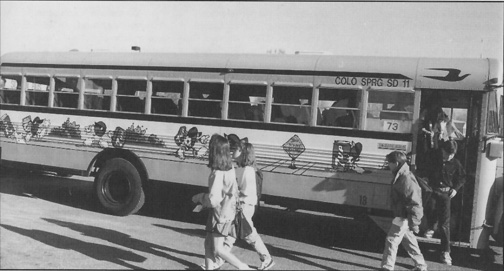Only two hundred years from the discovery, dear Chewana
-from "The English in the Daughter of a Wasco/Sahaptin Woman, Spoken in the Absence of Her Mother's True Language"
The title of that last poem shows Woody's awareness of her greatest challenge as a prophetic poet - she must write in English. Her family background is Warm Springs, Wasco, Yakama, Pit River and Navajo; she is an enrolled member of the Confederated Tribes of Warm Springs, Oregon; she grew up hearing her grandparents speak Sahaptin and Wasco. But those tongues are lost to her, except for their sounds, their rhythms, and a few precious phrases.
Woody works hard to twist English well. In her third book, Seven Hands, Seven Hearts (Eighth Mountain Press), which was also published in 1994, she tells fun family stories, writes clear, lyrical poems, and includes the full text of Hand into Stone. But in Luminaries of the Humble she is trying to capture the voice of her land itself. She is writing English poetry with echoes of her ancient languages' rhythms and sounds. Listen to these lines:
Woody accomplishes her difficult purpose in many lines and stanzas, and in some full poems. She is pushing her language towards a hard, crystalline clarity. Sometimes the lines are merely rocky. Sometimes the poems are murky, not clear. But when she succeeds, as in the poem "The Invisible Dress," she gives her readers a gift of graceful and challenging prophecy. The invisible dress is tanned deer hide; it is made of water; it is soaked in brains and scraped with a rib bone; it is lighted with symbols; it is patterned with song; it is given in dream; it is about survival.
Living With Crass Commercialism
Reviewed by Andy Bauck
|
A Survival Guide for a Consumer Society By Michael F. Jacobson and Laurie Ann Mazur Westview Press, 1995 -$18.95, 260 pages |
"There are almost no limits or boundaries to commercialism, except perhaps beer commercials interrupting presidential speeches or billboards by the Grand Canyon or in front of Mount Rushmore." -From the Foreword by Ralph Nader
Have you ever been annoyed by telemarketers interrupting your peace to beg you to change long-distance companies, or grown dizzy from being constantly surrounded by advertising? Part exposé and part activist manual, Marketing Madness is a highly critical examination of the many ways corporations invade our private lives and public institutions. Written by Laurie Ann Mazur and Michael Jacobson, a co-founder of the Center for the Study of Commercialism, the book also includes a foreword by Ralph Nader.

Using school buses to sell 7-Up
Although Marketing Madness thoroughly covers well-discussed topics such as TV advertising, junk mail, and marketing geared towards children, it also includes in-depth consideration of many less publicized but equally important issues. For example, Jacobson and Mazur's well-documented discussion of the alcohol and tobacco industry tactic of using charitable donations to buy silence from civic groups and improve their corporate image (frequently spending far more to publicize a donation than they gave in the first place) is sure to be eye-opening even to the most jaded corporate critic. Other chapters cover the degrading ways advertising presents women, and the corporate trend of making consumers feel good about spending by using social issues as a selling point.
A Worker Writes About Work
Reviewed by Robert Pavlik
Free Press contributor
|
A Brief Examination of Work By Reg Theriault W.W. Norton and Company, 1995 188 pages, hardbound, $18.00 |
Despite the huge body of literature on labor history, there are relatively few titles that relate to the work itself. A few notable examples come to mind: Studs Terkel's compilation of interviews with a broad cross-section of the labor force, entitled Working (1972); Antler's epic poem, Factory (1980); and Bertoldt Brecht's ode to the common man, A Worker Reads History. Beyond that, and a handful of titles published by the now-defunct Singlejack Press, one is hard pressed to read anything worthwhile about the experience of working.
Robert Pavlik is an environmental planner with the California Department of Transportation. He lives and works in San Luis Obispo.
 |
 |
 |
 |
 |
Contents on this page were published in the February/March, 1996 edition of the Washington Free Press.
WFP, 1463 E. Republican #178, Seattle, WA -USA, 98112. -- WAfreepress@gmail.com
Copyright © 1996 WFP Collective, Inc.
